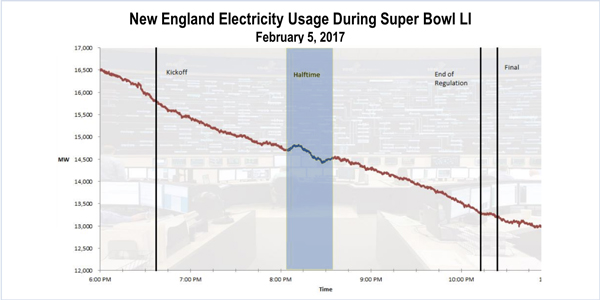By Michael Kuser
It seems that New England’s grid reacts just as excitedly as the region’s fans when the Patriots play for the NFL championship.
On Thursday, ISO-NE’s newsletter, Newswire, featured a timely article about the Patriots’ ninth Super Bowl appearance last year, which saw the team come from behind in a dramatic overtime win.
As the game moved into overtime, grid operators saw demand suddenly level off and then inch back up. At times, demand increased by as much as 50 MW during overtime, the RTO said.
“We can definitely see the demand changes on the system, in real time, by what’s happening in the Super Bowl,” said John Norden, the RTO’s director of operations. “Whether it’s the beginning of the game, halftime or the end of the game, we can see changes in levels of consumer demand. Understanding what is going on in real time, from a societal level, is very important to us, and we monitor that from our control room.”
Sounds like someone has a very good excuse to watch the big game on company time.
ISO-NE has had plenty of chances to study the “Patriots effect” — and ran a similar analysis prior to last year’s Super Bowl.
The RTO is not alone in its interest in the topic. Matt Chester, an energy and policy professional in D.C., posted a Jan. 31 blog piece analyzing electric power usage data during the last five Super Bowls showing that “versus a typical Sunday afternoon/evening in the winter, home power usage was 5% lower during the Super Bowl, with big consequences for overall energy use.”
ISO-NE said Super Bowl load curves have formed consistent patterns over the years, with upticks in demand coinciding with halftime, commercials and the end of the game. These mini spikes occur when millions of people all choose the same moment to open their refrigerators, use microwave ovens and flush toilets. Many homes in New England use wells, and any use of water triggers an electric pump.
For its part, PJM showed its support of the underdog Philadelphia Eagles by posting photos of pregame festivities on Twitter. It also promoted its new PJM Now mobile app for tracking the load curve and LMPs in real time during the game.



